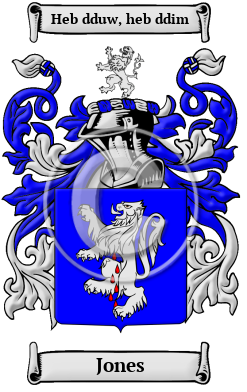-
Birth name
CHELSEA MARIE LAUTERBACH RUMERY
-
SURNAME HERITAGE
Wales Ireland

Jones History, Family Crest & Coats of Arms
While the ancestors of the bearers of Jones came from ancient Welsh-Celtic origins, the name itself has its roots in Christianity. This surname comes from the personal name John, which is derived from the Latin Johannes, meaning “Yahweh is gracious.”
This name has always been common in Britain, rivaling William in popularity by the beginning of the 14th century. The feminine form Joan, or Johanna in Latin, was also popular, and the surname Jones may be derived from either the male or female name. “Though its origins are in England, the surname is predominately held by people of Welsh extraction due to the overwhelming use of patronymics in Wales from the 16th century and the prevalence of the name John at that time.” 1 “Next to John Smith, John Jones is probably the most common combination of names in Britain.” 2
Early Origins of the Jones family
The surname Jones was first found in Denbighshire (Welsh: Sir Ddinbych), a historic county in Northeast Wales created by the Laws in Wales Act 1536, where their ancient family seat was at Llanerchrugog.
The name Jones, currently one of the most prolific in the world, descends from three main sources: from Gwaithvoed, Lord Cardigan, Chief of one of the 15 noble tribes of North Wales in 921; from Bleddyn Ap Cynfyn, King of Powys; and from Dyffryn Clwyd, a Chieftain of Denbighland.
All three lines merged in Denbighshire about the 11th century and it is not known which of the three can be considered the main branch of the family. Later some of the family ventured into England. “[The parish of Astall in Oxfordshire] was formerly the residence of Sir Richard Jones, one of the judges of the court of common pleas in the reign of Charles I.; and there are still some remains of the ancient manor-house near the church, which are now converted into a farmhouse.” 3
“Llanarth Court [in Monmouthshire], the admired seat of John Jones, Esq., is a handsome and spacious mansion, the front ornamented with an elegant portico resembling that of the temple of Pæstum.” 3


